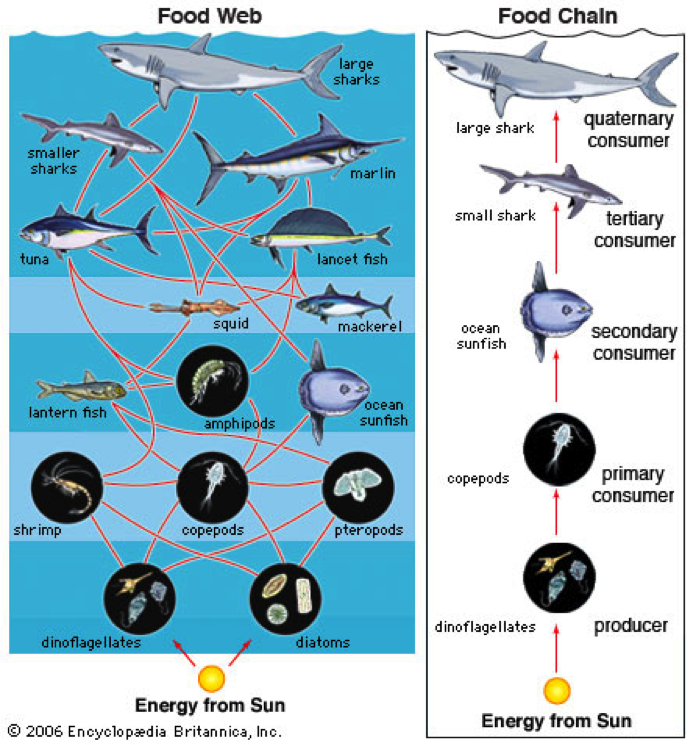Energy and Food Webs Biology Diagrams
Energy and Food Webs Biology Diagrams When a herbivore eats a plant, and then a carnivore eats the herbivore, the sequence of events is called a food chain. Each plant or animal is a link in a chain. The animal at the top of a food chain is often called a 'top predator' because it is not normally eaten by anything. In a rocky shore ecosystem there may be hundreds of food chains.

They form the foundation of the ocean food chain. Producers in the ocean food chain are mostly invisible, although they are great in numbers. They are one-celled organisms called phytoplanktons that cover the ocean's upper layer. Some photoautotrophic bacteria capture the sun's energy to produce food by photosynthesis. In the coastal areas This process is very important and means that even top-level consumers are contributing to the food web as the decomposers break down their waste or dead tissue. Changes to food webs. The effect of removing or reducing a species in a food web varies considerably depending on the particular species and the particular food web. interconnecting food chains of different animals in an ecosystem. If one chain of the web becomes undone then problems can happen. This diagram is one example of a food web in the ocean. Learn how another ocean food chain and food web works with Celeste by clicking on the California Coast Food Web video at www.randallmuseum.org.
PDF Topic/Lesson: Food Chain Objectives Biology Diagrams
6) Teacher models making a food chain diagram with arrows, starting with the sun and ending with species at the top of the food chain. 7) When done researching, partners must create a food chain diagram beginning with the sun and ending with whatever hunts or eats sturgeon, using construction paper and drawing/coloring materials. This food web diagram shows some of the feeding relationships between producers, consumers and decomposers in an onepū/sandy shore habitat. Diagram based on the originals from the New Zealand Ministry of Education's Building Science Concepts Book 22 Tidal Communities: Interdependence and the Effects of Change. Download a PDF version here.

6. Have a whole-class discussion about the marine ecosystems and food chains. Invite small groups to share their completed Feeding Frenzy worksheets with the whole class. Review each of the five food chains, as well as the ecosystems in which each food chain is likely to be found. Ask: the example food chain from the overhead fits within the larger food web; a food web is made up of multiple food chains. Show the overhead Coastal Arctic Food Web. Identify the animals that were not included with the class list. Coastal Arctic Food Web humans ringed seals cod krill phytoplankton gulls eider ducks clams bearded seals murres ice Further explore marine habitats, marine food webs and Marine organisms and adaptations. Activity ideas. Try these similar activities: Making a food web is a practical way for students to understand the complexity of food webs. Marine ecosystem this interactive diagram explores food webs and other aspects of life in the sea.
